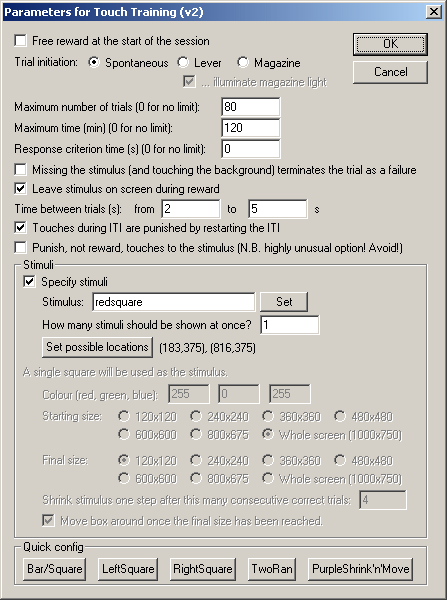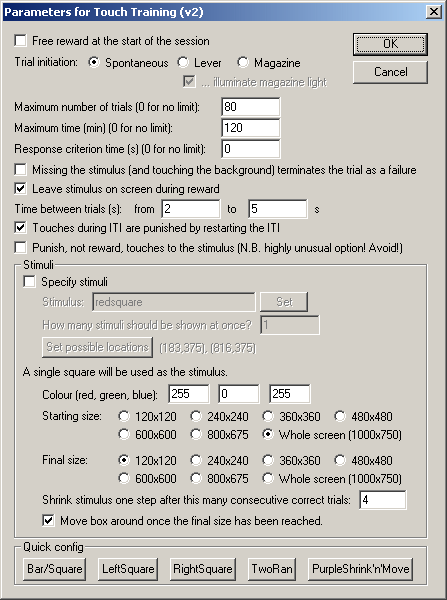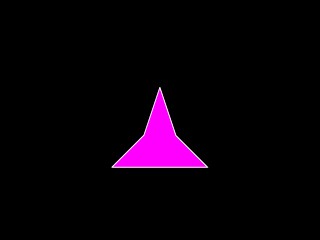Summary
Reinforces responding to stimuli on a touchscreen.
About the task
Purpose: to train the subject to touch stimuli.
A trial begins and marker sound 1 is played. Object(s) are presented on the screen. If the subject responds correctly within a criterion time, reward it. Punish the subject if it fails to respond in time (if you've set a time limit), or if it misses the stimulus and touches the background instead (if you've chosen to punish this).
Configuring the task

| • | Free reward at the start of the session. If selected, a single free reward (defined in the General Parameters) is delivered as the session starts. |
| • | Trial initiation. Can be (a) spontaneous; (b) requiring a lever response to start each trial (see also Use with Dogs); (c) requiring a food magazine response to start the trial (and in this case, there is the option to illuminate the magazine light to indicate that such a response is required). |
| • | Maximum number of trials. When the subject has performed this number of trials, the task ends. (You may specify 0 for no limit, though you must specify a limit on the number of trials, the time, or both.) |
| • | Maximum time. When this time elapses, the task is terminated as soon as the current trial has finished. (You may specify 0 for no limit, though you must specify a limit on the number of trials, the time, or both.) |
| • | Response criterion time. If the subject fails to respond to a stimulus within this time, an omission is scored. |
| • | Missing the stimulus terminates the trial as a failure. If ticked, the trial is terminated if the subject touches the background. Otherwise, the subject can touch the background first and later touch the stimulus, or (if Strict Touches are not selected in the General Parameters) can 'slide' onto the stimulus. |
| • | Leave stimulus on screen during reward. Pretty self-explanatory, I hope... |
| • | Time between trials. Specify a minimum and a maximum intertrial time (they may be the same). The actual time is chosen with a rectangular probability distribution within these values. The time between trials starts after any reward or punishment from the previous trial has finished. |
| • | Touches during ITI are punished by restarting the ITI. Fairly obvious. |
| • | Punish, not reward, touches to the stimulus. If ticked, touching the stimulus delivers punishment (defined in the General Parameters) rather than reward, even though the response is marked as the "correct thing to do" in the database. Highly unusual - avoid! Implemented for a very specific extinction-like experiment, not for general touch training. |
Stimuli
| • | Specify stimuli. If ticked, you specify the stimuli exactly. If not, a square is used (and it can shrink as time goes by). |
Options available if "Specify stimulus" is ticked:
| • | Stimulus. Choose the stimulus (click Set to select from the list of available stimuli). |
| • | How many stimuli should be shown at once? Self-explanatory. |
| • | Set possible locations. Click to choose the Locations used for the stimuli. |
Options available if "Specify stimulus" is not ticked:
| • | Colour (red, green, blue). Specify the square's colour. Each value (red, green, blue) can be from 0 to 255. |
| • | Starting size. Specify the size that the stimulus starts at. |
| • | Final size. Specify the size that the stimulus finishes at. |
| • | Shrink stimulus... after this many consecutive correct trials. When the subject performs this many trials correct in a row, the stimulus shrinks one step (until it reaches the final size). |
| • | Move box around once the final size has been reached. If this is ticked, then once the stimulus has reached the final size and the subject performs n correct trials in a row (where n was defined in Shrink stimulus...) then the stimulus starts to move around randomly on each trial. |

Quick configuration; mimicking previous Arachnid and CamCog programs
Click Bar/Square, LeftSquare, RightSquare, TwoRan[dom], or PurpleShrink'n'Move to choose a predefined scheme. The first four mimic the University of Cambridge training programs TSCR-BAR, SQUARE, LEFTSQUARE, RIGHTSQUARE, and TWORAN, though you still need to choose the stimulus to use. For exact compatibility with these programs, use a wide bar stimulus for Bar/Square and a square for the others. The last (PurpleShrink'n'Move) mimics Cambridge Cognition's previous edition of MonkeyCANTAB.
What constitutes "reward" and "punishment"?
Options for reward and punishment are set in the General Parameters section; visual objects are defined in the Visual Object Library.
More on displaying objects
The task works with an internal scaling system based on a display that is 1000 units (pixels) wide and 750 high. If you specify the stimulus, it should fit into a rectangle that is 267 (w) x 200 (h). Imagine that the screen is divided into nine. (See this diagram ("Size and coordinates").) The possible locations are these nine boxes.
Screenshot from the task
Touch, my monkey. TOUCH IT!
